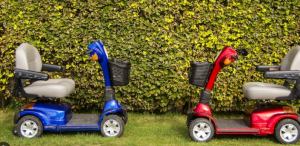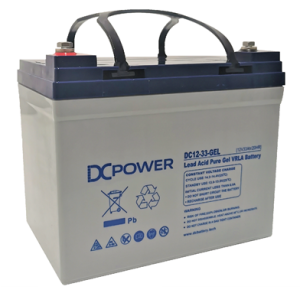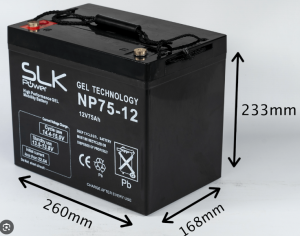Gel batteries, with their leak-proof design and ability to recover from deep discharges, are highly suitable for mobility scooters, offering a longer lifespan and consistent performance despite their higher upfront cost and increased weight.
Understanding Gel Batteries
Gel batteries, a type of lead-acid battery, stand out for their unique composition and function. Unlike traditional lead-acid batteries, gel batteries contain a silica-based gel in which the electrolytes are suspended. This gel formulation allows electrons to flow freely between the plates, a key factor in the battery’s operation.
Composition and Function
Gel batteries utilize a thickening agent to turn the electrolyte into a gel-like substance. This alteration in the battery’s internal structure provides several benefits, such as reducing leakage and allowing for a more stable and consistent power output. These batteries typically operate at a voltage of 12 volts, with capacities that can range significantly depending on the size and specifications of the battery.
Advantages of Gel Batteries
Durability and Safety: Gel batteries are known for their robustness and ability to withstand harsh conditions. They are less prone to spillage and can operate efficiently in a wide range of temperatures, making them ideal for mobility scooters that require reliable performance under various environmental conditions.
Maintenance-Free: One of the significant advantages of gel batteries is their maintenance-free nature. Unlike traditional lead-acid batteries that require regular topping up with distilled water, gel batteries are sealed and do not need this level of upkeep, saving users time and effort.
Long Lifespan: Gel batteries generally have a longer lifespan compared to other battery types used in mobility scooters. While a standard lead-acid battery might last for about 300 to 500 charge cycles, gel batteries can extend beyond 500 cycles, offering better value over time.
Deep Discharge Recovery: They are capable of surviving deeper discharge cycles without significant damage. This capability is crucial for mobility scooter users who may depend on their scooters for extended periods without access to charging facilities.
Limitations of Gel Batteries
Higher Initial Cost: The advanced technology and benefits of gel batteries come at a higher price point. The initial investment for a gel battery can be significantly more than that for a standard lead-acid battery, posing a barrier for some users.
Sensitive Charging Requirements: Gel batteries require specific chargers that can regulate the charge to suit their needs. Using an incorrect charger can damage the battery, affecting its lifespan and performance. This specificity adds an extra layer of complexity for users.
Weight and Size: Gel batteries tend to be heavier and larger than their lithium-ion counterparts. This increased weight and size can impact the mobility scooter’s performance, especially in terms of speed and maneuverability.
Gel Batteries vs. Lead-Acid Batteries
Gel Batteries
Gel batteries, a subtype of VRLA (Valve-Regulated Lead-Acid) batteries, use a gelified electrolyte which provides several advantages over traditional lead-acid batteries. Their main benefit is the reduced risk of leakage and lower maintenance since they don’t require water to be added. This makes them particularly suitable for applications where maintenance is difficult. Gel batteries also offer better performance in extreme temperatures and have a longer lifespan due to their resistance to sulfation.
Lead-Acid Batteries
Lead-acid batteries are the oldest type of rechargeable battery, known for their high power output and low cost. They are widely used in automotive applications, UPS systems, and for emergency lighting. Despite their widespread use, lead-acid batteries require regular maintenance, including water top-ups, and can spill or leak if not maintained properly. They also have a shorter lifespan compared to gel and lithium-ion batteries, especially under frequent discharge and recharge cycles.
| Feature | Gel Batteries | Lead-Acid Batteries |
|---|---|---|
| Maintenance | Low | High |
| Cost | Higher initial cost | Lower initial cost |
| Risk of Leakage | Low | High |
| Temperature Performance | Better in extreme temperatures | Poorer in extreme temperatures |
| Lifespan | Longer | Shorter |
| Applications | Solar systems, marine, mobility aids | Automotive, UPS, emergency lighting |
Gel Batteries vs. Lithium-Ion Batteries
Gel Batteries
Gel batteries excel in safety and temperature tolerance. They are less prone to leaking and can operate in a wider range of temperatures compared to lithium-ion batteries. Gel batteries also do not require a complex management system to ensure their safety during operation. Their main drawbacks are lower energy density and higher weight than lithium-ion batteries, making them less ideal for applications requiring high power in a compact form.
Lithium-Ion Batteries
Lithium-ion batteries are favored for their high energy density, lightweight, and long lifespan. They are the preferred choice for portable electronics, electric vehicles, and renewable energy storage solutions. Lithium-ion batteries can deliver a higher power output and recharge much faster than gel batteries. However, they are more expensive and require a battery management system to prevent overheating and ensure safety.
| Feature | Gel Batteries | Lithium-Ion Batteries |
|---|---|---|
| Energy Density | Lower | Higher |
| Weight | Heavier | Lighter |
| Safety | Higher (less prone to leaking) | Requires management system |
| Cost | Lower | Higher |
| Lifespan | Up to 7 years | Up to 10-15 years |
| Charge Speed | Slower | Faster |
Performance Comparison
When comparing gel batteries with lead-acid and lithium-ion batteries, several key factors emerge:
- Gel batteries offer a middle ground in terms of cost, performance, and maintenance between lead-acid and lithium-ion batteries. They are safer and have a longer lifespan than lead-acid batteries but are surpassed by lithium-ion batteries in terms of energy density and charge speed.
- Lead-acid batteries are cost-effective and provide high power output but fall short in safety, maintenance, and lifespan.
- Lithium-ion batteries stand out for their high energy density, lightweight, and longer lifespan but come at a higher cost and require more sophisticated management to ensure safety.
Choosing the right battery type depends on the specific requirements of the application, including budget, size, weight, and performance needs. For applications where maintenance is difficult and safety is a concern, gel batteries are a reliable choice. In scenarios demanding high energy in a compact size, lithium-ion batteries are unmatched. For cost-sensitive applications requiring high power, lead-acid batteries remain a viable option.
Gel Batteries in Mobility Scooters
Suitability for Mobility Scooters
Gel batteries, known for their leak-proof design and deep cycle capabilities, stand out as a superior choice for mobility scooters. These batteries employ a silica-based gel that suspends the electrolytes, allowing for a more consistent discharge and recharge cycle. This characteristic makes them particularly well-suited to the stop-start nature of mobility scooter use.
Key Advantages:
- Reduced vibration impact: Gel batteries can handle vibrations and impacts better than their counterparts, ensuring a longer lifespan under the daily use conditions of mobility scooters.
- No leakage: The gel-based technology eliminates the risk of leakage, making them safer for use in mobility scooters, where battery integrity is crucial.
- Deep discharge recovery: They are capable of recovering from deep discharge situations more effectively than other battery types, a common scenario for mobility scooters used irregularly.
Drawbacks:
- Higher upfront cost: The initial investment in gel batteries is higher, although this is offset by their longer lifespan and lower maintenance requirements.
- Weight and size: Gel batteries tend to be heavier and larger than lithium-ion batteries, which can affect the mobility scooter’s weight distribution and portability.
User Experiences with Gel Batteries
Users consistently report high satisfaction with gel batteries in mobility scooters, citing their reliability and maintenance-free nature as key benefits. The ability of gel batteries to maintain a charge over longer periods of inactivity is especially valued by users who do not use their mobility scooter daily.
Positive Feedback:
- Consistent performance: Users note the consistent power output and performance, enhancing the user experience.
- Longevity: Many report using their gel batteries for several years before needing a replacement, indicating a good return on investment.
Negative Feedback:
- Initial cost concerns: The higher purchase price is a common concern among new users, though many acknowledge the cost benefits over time.
- Weight: Some users find the increased weight of gel batteries makes manual handling of the scooter more challenging.
Maintenance and Care Tips
Proper maintenance can significantly extend the life of a gel battery, ensuring that mobility scooter users experience uninterrupted service and performance.
Maintenance Tips:
- Regular charging: Keep the battery fully charged when not in use, especially during periods of prolonged inactivity.
- Temperature considerations: Store and charge the battery in a temperature-controlled environment to prevent damage and preserve battery life.
- Visual inspections: Regularly inspect the battery for signs of wear or damage, addressing any issues promptly to avoid more significant problems later.
Care Tips:
- Use appropriate chargers: Always use a charger designed for gel batteries to prevent overcharging and undercharging.
- Avoid deep discharges: While gel batteries handle deep discharges better than others, it’s still advisable to avoid completely depleting the battery to maintain its health.
- Clean terminals: Keep the battery terminals clean and free from corrosion to ensure optimal performance and connectivity.
By adhering to these maintenance and care tips, users can maximize the lifespan and performance of their gel batteries, making them a highly effective power source for mobility scooters.
Lifespan of Gel Batteries
Durability and Longevity
Gel batteries typically offer a lifespan of 5 to 7 years, which can extend up to 10 years under optimal conditions such as proper maintenance and usage within recommended temperature ranges. The key to their longevity lies in their gel electrolyte, which minimizes evaporation and leakage, reducing the risk of damage and sulfation. This characteristic makes gel batteries particularly resilient in cyclic use applications, where they outperform traditional lead-acid batteries that usually last between 3 to 5 years.
Initial Costs vs. Long-Term Benefits
Investment Analysis
While gel batteries command a higher initial price compared to standard lead-acid batteries, their extended lifespan and lower maintenance requirements contribute to a more favorable cost of ownership over time. For instance, a gel battery costing 20-30% more upfront can result in longer service life and reduced replacement costs, effectively lowering the total cost per year of operation. This makes them a cost-effective solution for applications where reliability and longevity are critical, such as solar energy storage, marine use, and mobility aids.
Cost Comparison with Other Battery Types
Economic Considerations Across Technologies
Comparing gel batteries to lithium-ion and traditional lead-acid batteries reveals distinct cost dynamics. A lithium-ion battery, while offering a higher energy density and a lifespan of up to 10-15 years, can cost significantly more than gel batteries—often twice as much or more. This higher cost reflects the advanced technology and materials used in lithium-ion batteries, such as cobalt and nickel. On the other hand, traditional lead-acid batteries, despite their lower initial cost, may require more frequent replacements and higher maintenance, eroding their cost advantage over time.
Gel batteries represent a middle ground in terms of both initial cost and operational longevity. They offer a balance between the upfront affordability of lead-acid batteries and the high performance and longevity of lithium-ion batteries. For users prioritizing a mix of moderate cost, maintenance convenience, and reliable performance, gel batteries emerge as a compelling choice.
The economic advantage of gel batteries becomes more pronounced in applications demanding stable power over extended periods with minimal maintenance. Their ability to sustain performance across a wide temperature range and resist vibrations and shocks further underscores their value proposition, particularly in remote or demanding operational contexts.


